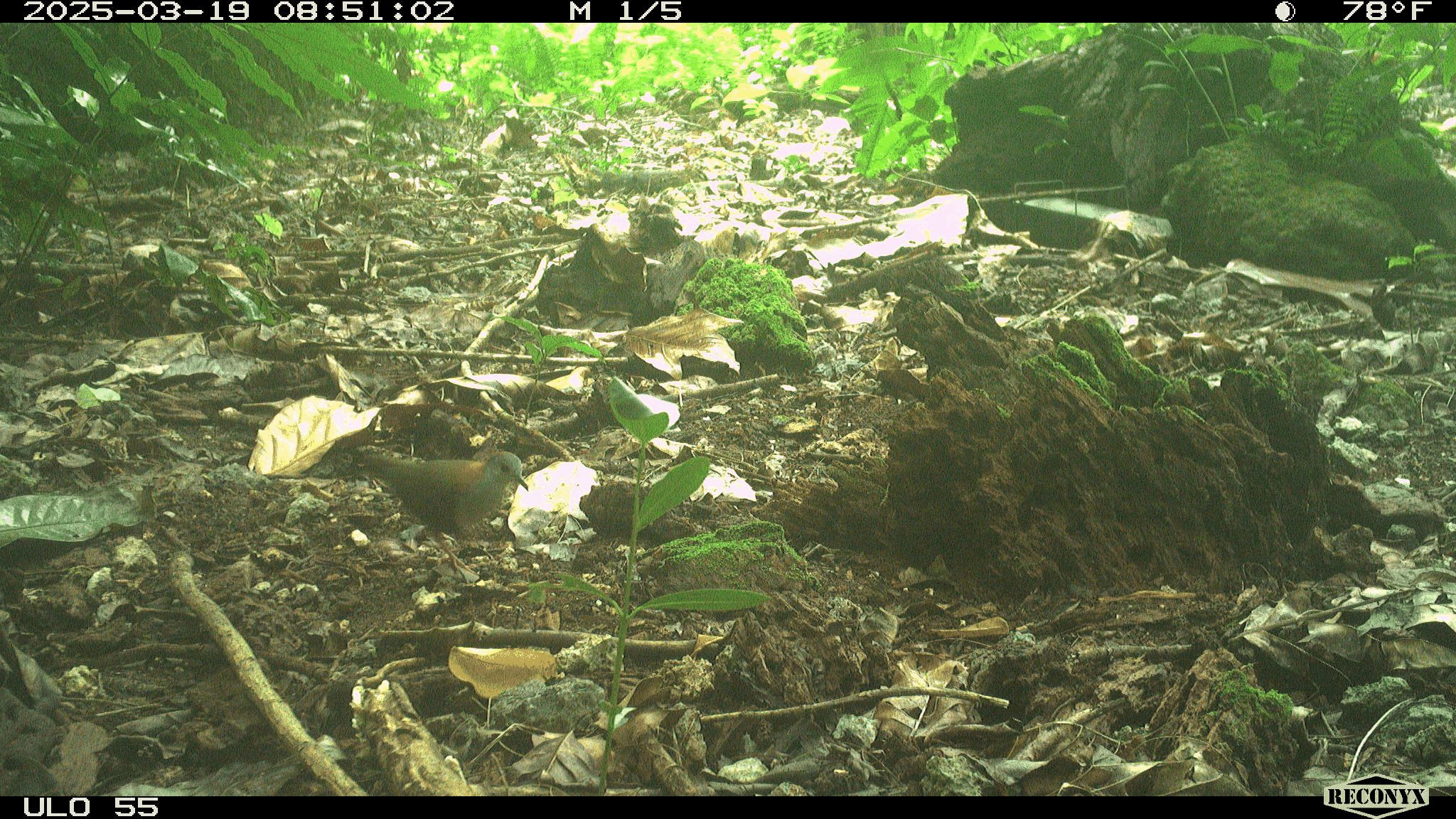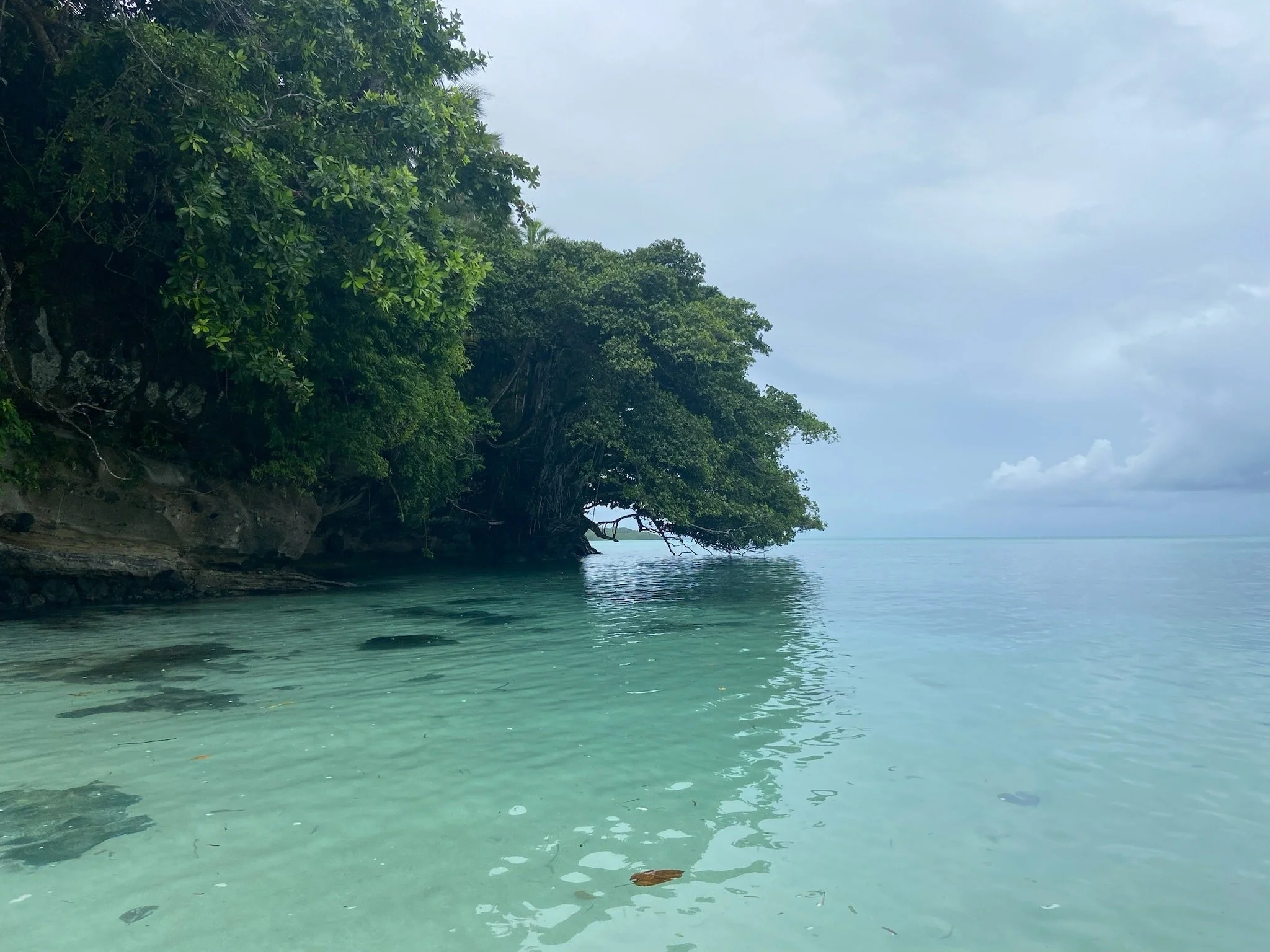Data Shows Endangered Palau Ground Doves and Land Crabs Swiftly Recovering After Successful Palauan Island Conservation Effort
Koror, Palau — October 2025 — Seabirds, the IUCN Endangered Palau Ground Dove (Pampusana canifrons), and other native species have significantly increased in number thanks to a successful restoration campaign on Ulong Island, Republic of Palau in the Western Pacific Ocean.
Island Conservation, the Koror State Government, the Koror State Department of Conservation and Law Enforcement (DCLE), and the Koror State Rangers worked together in 2023-2024 to remove introduced, damaging invasive rats which devoured native bird eggs and young, decimated native plant populations through seed predation, preyed on native crabs, and disrupted food webs—ultimately threatening ecosystem collapse.
Now, after one full year of rigorous monitoring—including trail cameras, eDNA sampling, and field surveys—the partners confirmed no invasive rodents remain on the island. This success marks a monumental step forward for conservation in Palau, the Micronesia region, and across the Pacific.
With the pressure of invasive species removed, signs of recovery in this unique ecosystem are already emerging. Island Conservation’s monitoring team noticed a higher incidence of Ground Doves, including sightings of chicks at landing sites where they were never previously recorded.
“The results are thrilling,” said Coral Wolf Impact Program Manager, Island Conservation. “We’re seeing and hearing recovery: since the program began, we’ve recorded a significant increase in calls from Brown Noddies, White Terns, and Bridled Terns. This increase occurred just one-year post-eradication—who knows what recovery remains to be discovered!”
These early indicators of success can be expected to cascade into the surrounding marine ecosystem, which will benefit from repaired nutrient flows between land and sea.
The acoustic data, processed by Conservation Metrics, shows a dramatic increase in bird calls across the project site. Trail cameras also captured footage of Endangered Palau Ground Doves safely navigating the forest floor.
Known the world over as one of the best diving locations in the world, Ulong is home to precious artefacts of pre-colonial indigenous culture. Its ancient caves contain paintings and pictographs signifying beliefs and activities that far preceded colonialization. These treasured cultural sites are couched in an equally priceless, finely tuned ecosystem, home to many rare species.
Tourists and their guides have also noticed the difference. Camping outings on Ulong Island have become more enjoyable, with fewer disruptions and a renewed sense of connection to the island’s natural beauty and cultural history. To safeguard this progress, the partners implemented a robust biosecurity protocol to prevent reinvasion and protect the long-term conservation investment.
Conservation has always been central to Palau’s identity, and in Koror, it strengthens both ecosystems and Palauan ways of life. The restoration work on Ulong is a shining example of what’s possible—not just for the Koror community, but for others across the Pacific who share their commitment to protecting island environments.
An animated GIF shows endangered Ground Doves safely exploring the forest floor. Credit: Island Conservation
Ulong Island is a part of the Island-Ocean Connection Challenge, a volunteer collective created by Island Conservation, Scripps Institution of Oceanography, and Re:wild to restore and rewild 40 globally significant island-ocean ecosystems by 2030.
Island Conservation’s impact team is currently analyzing monitoring data, including seabird point counts, camera trap footage (Palau Ground Dove, Micronesian Megapode, and land crab), and stable isotope samples. These findings will be integrated into a broader island-ocean context in collaboration with Scripps Institution of Oceanography, with full initial results expected by early next year.
“This project shows the world what’s possible when a partnership of culture, conservation and innovation unite,” said Tommy Hall, Project Manager at Island Conservation. “Seeing endangered species rebounding so quickly reminds us that nature is resilient; and with biosecurity securing the future, Ulong Island stands as a beacon of success for Pacific islands.”
Photo credit: Island Conservation/Coral Wolf
About the project:
The Ulong Island Restoration Project was made possible by the leadership of the Koror State Government, supported by Island Conservation, the Koror State Department of Conservation and Law Enforcement (DCLE), and the Koror State Rangers. Support for the project was provided by the U.S. Department of the Interior’s Office of Insular Affairs, the David and Lucile Packard Foundation, Oceankind, Bell Laboratories Inc., the Moore Family Charitable Foundation, the Dawson Family Fund, the Wanderlust Fund, the Fields family, and other island advocates around the world.
And of course, it would not be possible without the support in the planning and implementation alongside our local and international project partners: Belau National Museum, Road Runner Logistics Palau, Air Champagne, Scripps Institution of Oceanography, Palau Environmental Quality Protection Board, Palau Coral Reef Research Foundation, One Reef, the Ebiil Society, Palau Conservation Society, and Sonsorol State.
Additional Quotes:
“The Office of Insular Affairs is very pleased that this project has successfully resulted in the return of birds, plants, and other animal life to revitalize the natural environment and to protect cultural history on Ulong Island in Palau. We congratulate Palau on conservation efforts to strengthen its ecosystems and island way of life and are pleased to be one of its many partners in this successful effort.” — William Hague, Principal Deputy Assistant Secretary for Insular and International Affairs, U.S. Department of the Interior. “
“The data from Ulong show just how resilient these island ecosystems can be when negative pressures, imposed by accident, are removed. Within a single year, we’re already hearing and seeing meaningful changes. It’s incredibly encouraging. We’re grateful to support Island Conservation, Koror State, and the local teams on the ground. Their leadership is making it possible for endangered species to recover, and we’re honored to help document that story through science.” — Matthew McKown, CEO, Conservation Metrics
Media Assets:
Field Camera Analysis, Acoustic Data, Photos and B-roll video: https://drive.google.com/drive/folders/1QgU8ofdSnnb7obl6HFYB4JaV1I_ouVs3?usp=drive_link
Interviews available upon request.
Media Contacts:
Sally Esposito, Senior Communications Director, Island Conservation sally.esposito@islandconservation.org
About the collaborators:
Island Conservation’s mission is to restore islands for nature and people worldwide. We are a United States-based 501(c)(3) charitable organization with a globally distributed team—often made up of local islanders who bring deep knowledge and connection to the places where we work. Together, we collaborate with local communities, government management agencies, and conservation organizations to holistically restore islands by bringing back biodiversity, the foundation of all healthy ecosystems. We do this by removing a primary threat (introduced, damaging invasive species) and accelerating the return of native plants and animals. We utilize innovative technology and techniques to work more efficiently and showcase the many benefits of holistically restored islands for biodiversity, climate resilience, ocean health, and sustainable development across the globe.
Conservation Metrics Founded in 2012, Conservation Metrics partners with communities, conservation NGOs, governments, and industry leaders to monitor species, ecosystem change, and outcomes from projects undertaken to improve the health of our planet. We transform monitoring data into actionable insights through the design of field surveys, custom AI species detection models, and scalable data infrastructure that strengthen community resilience and support long-term conservation. By co-creating rigorous, culturally grounded monitoring programs, we help partners make informed decisions that protect ecosystems and sustain the planet for future generations.




